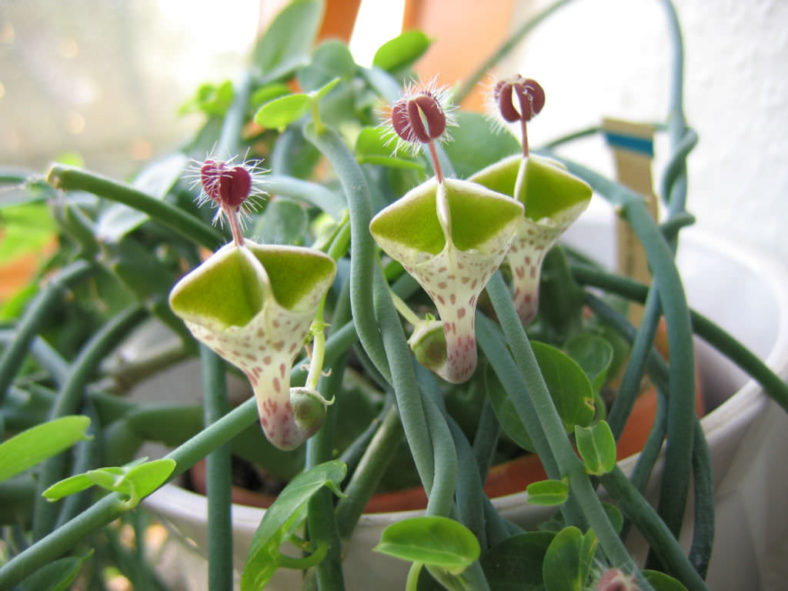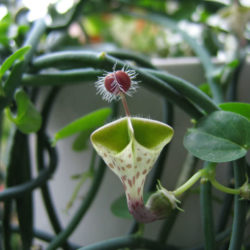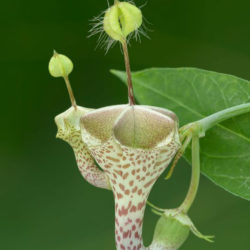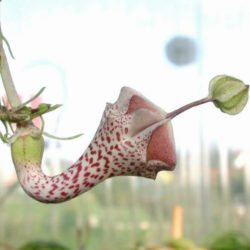Scientific Name
Ceropegia haygarthii Schltr.
Common Name(s)
Bushman's Pipe, Lantern Flower, Necklace Vine, Parachute Flower, Parasol Flower, Rosary Vine, Snake Creeper, Wine-glass Vine
Synonym(s)
Ceropegia distincta subsp. haygarthii, Ceropegia tristis
Scientific Classification
Family: Apocynaceae
Subfamily: Asclepiadoideae
Tribe: Ceropegieae
Genus: Ceropegia
Description
Ceropegia haygarthii is a vigorous succulent with climbing or trailing stems that bear small, green leaves. The stems are fleshy, green, covered with a waxy coating, and grow up to 10 feet (3 m) long and 0.25 inches (0.5 cm) in diameter. Leaves are fleshy, flat, oval, and rarely over 1 inch (2.5 cm) long.
The plant produces a profusion of unusual flowers in spring. The flowers are pinkish-white or greenish-tinted with a purple-spotted tube that widens towards the top and terminates in five abruptly narrowed segments with tips twisted together into a long, stalk-like, dull purple or purple-brown structure with a hairy knob at the end. The flowers are up to 1.6 inches (4 cm) long and 1 inch (2.5 cm) in diameter. Fruits are narrow, green, or sometimes purplish follicles recurved at the tips and up to 5.6 inches (14 cm) long.
Origin
Ceropegia haygarthii is native to subtropical parts of South Africa (Eastern Cape, KwaZulu-Natal, Mpumalanga, and Limpopo) and southern Mozambique.
Etymology
The specific epithet "haygarthii (hay-GARTH-ee-eye)" honors Walter Jacques Haygarth (1863-1950), an engineer, draughtsman, and plant collector who worked with John Medley Wood (1827-.1915).

Hardiness
USDA hardiness zone 10a to 11b: from 30 °F (−1.1 °C) to 50 °F (+10 °C).
How to Grow and Care
A gritty compost is suitable, and clay pots help with drainage, especially for the species with white thickened roots, which are the most susceptible to rotting, and for species forming large tubers. Ceropegias appreciate water and a little fertilizer during warm weather, although some care with watering is required for the more difficult species. The vine-like species can suffer from prolonged drought.
Typically, many of these species grow and climb naturally among bushes which provide shade and humidity to the base, while the vegetative growth is in the light. Where tubers occur, they are best planted on the compost surface, and the vegetative growth is allowed to twine around supports or trail down from a hanging pot. The latter growth mode has the advantage of not using valuable bench space. Small tubers formed at joints in the thin stems of some species can be used for propagation. If the tuber rots or dries out, don't panic. If some of the top growth is still in reasonable condition, it may be possible to save the plant by re-rooting stems in damp gravel.
See more at How to Grow and Care for Ceropegia.
Links
- Back to genus Ceropegia
- Succupedia: Browse succulents by Scientific Name, Common Name, Genus, Family, USDA Hardiness Zone, Origin, or cacti by Genus
Photo Gallery
Click on a photo to see a larger version.



